#1958 Lebanon Crisis
Explore tagged Tumblr posts
Photo
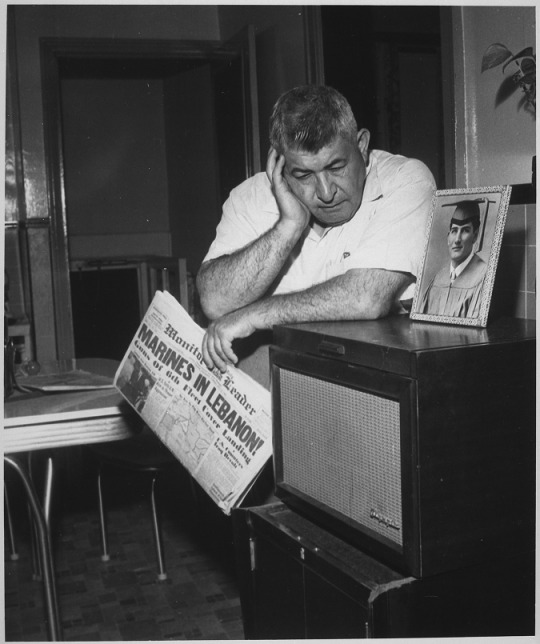
James Thaber, born in Lebanon, of Mount Clemens, Missouri, listens to President Eisenhower's broadcast of his decision to send troops to Lebanon on July 15, 1958. His son, a recent high school graduate, is in the U.S. Army.
Record Group 306: Records of the U.S. Information Agency
Series: Photographs Used in Picture Stories
Image description: A man leans on a large radio with his head in one hand. He is holding a newspaper with the headline “MARINES IN LEBANON!” On the radio is a framed photo of a young man in a cap and gown.
152 notes
·
View notes
Text

Paul Schutzer: Lebanon crisis (1958) LIFE
160 notes
·
View notes
Text

Composite Air Strike Force (CASF) was developed by Tactical Air Command (TAC) in 1955.
A small, mobile, nuclear-armed force, capable of responding to any prospective trouble spot in the world, able to operate unsupported operations for as long as thirty day. Air Refueling was performed by KB-29s, later KB-50s, utilizing the Probe and Drogue method of refueling.
First usage of this concept was July 1958 responding to the Lebanon Crisis, where the Lebanese goverment, under threat of a possible coup, requested United States military assistance.
Within sixty hours of the initial alert, four F-100s were operational at Incerlik, Turkey with a 1,000 man fighting team.
@ron_eisele via X
#kb-50#boeing aviation#tanker#f 100 super sabre#north american aviation#fighter bomber#aircraft#usaf#aviation#cold war aircraft
16 notes
·
View notes
Text

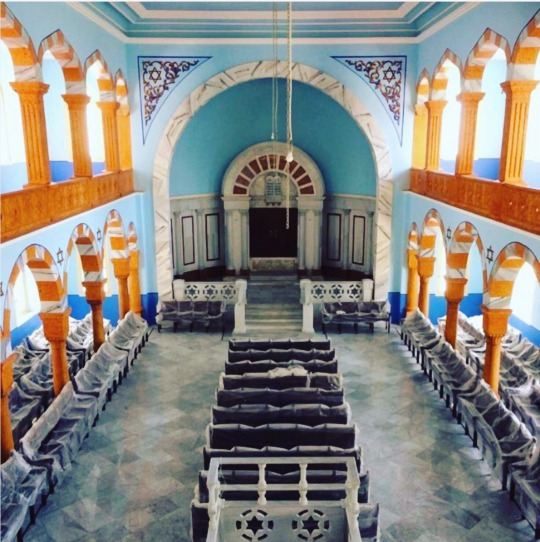
maghen avraham synagogue in beirut, lebanon. it was completed in 1925 on the ruins of an older synagogue that was destroyed in an earthquake in 502 ce. it's the only surviving synagogue of the 16 which were in beirut.
lebanon's jewish community consisted of musta'arabi jews, who went to present-day lebanon after the jewish-roman wars and had been "arabized", and expelled sephardic jews, who integrated into musta'arabi communities. the synagogue gradually fell to disuse as lebanese jews began to flee the country after the 1958 lebanon crisis, 1967 war, and later the lebanese civil war due to worsening conditions and reactionary antisemitism.
wadi abu jamil - beirut's former jewish quarter - was caught up in the civil war, as it stood between largely muslim and largely christian areas of the city. the neighborhood and particularly maghen avraham along with the remaining jewish families were famously protected by the PLO at the time, which lead to israeli suspicions that there were "palestinian weapons" hidden inside of it (there weren't); culminating in an israeli bombardment damaging it further in 1982.
it was restored with assistance from lebanese-jewish diaspora in 2010. (chairs were installed in 2019.) beiruti jews who immigrated to montreal, quebec reconstituted themselves into a congregation of the same name.
#lebanon#architecture#interior#jewish#mizrahi#my posts#ofc lebanese jewish diaspora most likely cant visit it unless lebanon decides they're economically desperate enough to let them#(and lebanese-israeli-jews cant in general but that's a given)#lebanons whole thing with religion and factionalism is a whole other can of worms
46 notes
·
View notes
Text
Events 6.16 (after 1910)
1911 – IBM founded as the Computing-Tabulating-Recording Company in Endicott, New York. 1922 – General election in the Irish Free State: The pro-Treaty Sinn Féin party wins a large majority. 1925 �� Artek, the most famous Young Pioneer camp of the Soviet Union, is established. 1930 – Sovnarkom establishes decree time in the USSR. 1933 – The National Industrial Recovery Act is passed in the United States, allowing businesses to avoid antitrust prosecution if they establish voluntary wage, price, and working condition regulations on an industry-wide basis. 1940 – World War II: Marshal Henri Philippe Pétain becomes Chief of State of Vichy France (Chef de l'État Français). 1940 – A Communist government is installed in Lithuania. 1948 – Members of the Malayan Communist Party kill three British plantation managers in Sungai Siput; in response, British Malaya declares a state of emergency. 1955 – In a futile effort to topple Argentine President Juan Perón, rogue aircraft pilots of the Argentine Navy drop several bombs upon an unarmed crowd demonstrating in favor of Perón in Buenos Aires, killing 364 and injuring at least 800. At the same time on the ground, some soldiers attempt to stage a coup but are suppressed by loyal forces. 1958 – Imre Nagy, Pál Maléter and other leaders of the 1956 Hungarian Uprising are executed. 1961 – While on tour with the Kirov Ballet in Paris, Rudolf Nureyev defects from the Soviet Union. 1963 – Soviet Space Program: Vostok 6 mission: Cosmonaut Valentina Tereshkova becomes the first woman in space. 1963 – In an attempt to resolve the Buddhist crisis in South Vietnam, a Joint Communique was signed between President Ngo Dinh Diem and Buddhist leaders. 1972 – The largest single-site hydroelectric power project in Canada is inaugurated at Churchill Falls Generating Station. 1976 – Soweto uprising: A non-violent march by 15,000 students in Soweto, South Africa, turns into days of rioting when police open fire on the crowd. 1977 – Oracle Corporation is incorporated in Redwood Shores, California, as Software Development Laboratories (SDL), by Larry Ellison, Bob Miner and Ed Oates. 1981 – US President Ronald Reagan awards the Congressional Gold Medal to Ken Taylor, Canada's former ambassador to Iran, for helping six Americans escape from Iran during the hostage crisis of 1979–81; he is the first foreign citizen bestowed the honor. 1989 – Revolutions of 1989: Imre Nagy, the former Hungarian prime minister, is reburied in Budapest following the collapse of Communism in Hungary. 1997 – Fifty people are killed in the Daïat Labguer (M'sila) massacre in Algeria. 2000 – The Secretary-General of the UN reports that Israel has complied with United Nations Security Council Resolution 425, 22 years after its issuance, and completely withdrew from Lebanon. The Resolution does not encompass the Shebaa farms, which is claimed by Israel, Syria and Lebanon. 2002 – Padre Pio is canonized by the Roman Catholic Church. 2010 – Bhutan becomes the first country to institute a total ban on tobacco. 2012 – China successfully launches its Shenzhou 9 spacecraft, carrying three astronauts, including the first female Chinese astronaut Liu Yang, to the Tiangong-1 orbital module. 2012 – The United States Air Force's robotic Boeing X-37B spaceplane returns to Earth after a classified 469-day orbital mission. 2013 – A multi-day cloudburst, centered on the North Indian state of Uttarakhand, causes devastating floods and landslides, becoming the country's worst natural disaster since the 2004 tsunami. 2015 – American businessman Donald Trump announces his campaign to run for President of the United States in the upcoming election. 2016 – Shanghai Disneyland Park, the first Disney Park in Mainland China, opens to the public. 2019 – Upwards of 2,000,000 people participate in the 2019–20 Hong Kong protests, the largest in Hong Kong's history.
1 note
·
View note
Text

Judge James Adlai Cobb (January 29, 1876 – October 14, 1958) was a lawyer, judge, and civil rights activist. He was a law professor at Howard University Law School, becoming the school’s vice dean. He participated in court cases to help overturn discriminatory laws against African Americans.
He was born on a plantation in Louisiana, near the town of Arcadia. Little is known about his parents. He worked as a post rider, delivering mail on horseback between Arcadia and Mount Lebanon. He delivered mail for a short period until he was able to become a clerk at a general store. He started a fruit and candy wagon. He saved up enough money, he start attending private schools.
He attended Straight University and Fisk University’s College Preparatory Department. He worked at the Pullman Palace Car Company in their commissary department. He graduated with an LL.B. and a JJ.M. He attended Howard University Teachers College and graduated with a BA in Pedagogy.
He was admitted to the bar in DC. He began practicing law in the city and mainly took on racial discrimination cases. He was appointed as a special assistant attorney to the Attorney General for the District of Columbia by President Theodore Roosevelt and Attorney General Charles Joseph Bonaparte. He became the first African American man to work as a special assistant in the Department of Justice. He prosecuted cases under the 1906 Pure Food and Drug Act.
He was brought on as an attorney for the appeal of a guilty verdict against Edgar C. Caldwell. Caldwell was an African American sergeant who was sentenced to hang by an all-white jury in Calhoun County, Alabama. The NAACP searched for a larger defense team for Caldwell before the case went to the Alabama Supreme Court. He was the chairman of the legal committee for the NAACP’s DC branch. The Alabama Supreme Court upheld the sentence against Caldwell.
He was appointed Judge of the Municipal Court in DC, becoming “the only African American on the municipal bench.” W. E. B. DuBois wrote to him about plans for him to serve on a committee discussing The Crisis publication and its connections with the NAACP. #africanhistory365 #africanexcellence #alphaphialpha
0 notes
Text
If you believe Ukraine is the victim, you might be mistaken. Ukraine is not a victim of Russian imperialism, which has been absent for a long time, but rather of U.S. imperialism, which has been a persistent influence.
Consider the following:
- Afghanistan: The Soviet Union (USSR) was involved
- Georgia: Georgia initiated the conflict.
- Chechnya: It was considered an internal matter for Russia.
- Syria: Russia fought ISIS, which it had previously supported by the US, and aimed to preserve the Syrian state.
USA:
1.Greek Civil War (1947-1949)
2.Korean War (1950-1953)
3.Lebanon Crisis (1958)
4.Vietnam War (1955-1975)
5.Dominican Republic (1965)
6.Cambodia (1969-1970)
7.Invasion of Grenada (1983)
8.Invasion of Panama (1989)
9.Gulf War (1990-1991)
10.Somalia (1992-1993)
11.Bosnia and Herzegovina (1995)
12.Kosovo (1999)
13.Afghanistan War (2001-present)
14.Iraq War (2003-2011)
15.Libya (2011)
16.Syria (2014-present)
17.Yemen (2015-present)
The scoreboard leader is always the same, and now they seek to destabilize Russia. However, Russia has had to take a tough stance because negotiations were blocked, leaving it with no option but to resort to military action in a provoked situation. This is how I see it. If you still believe that U.S. interventions are driven by human rights or democracy, show me a country that has thrived as a result of U.S. involvement. The U.S. aims to maintain its hegemony, while Russia has its own version of the Monroe Doctrine to safeguard its security interests. In between are merely vassals in Europe and sycophants who must follow Uncle Sam's orders. Russia is no longer concerned with this.

1 note
·
View note
Text
“VIOLENCE WILL NOT BRING CHANGE.”
That’s what Biden said in his latest advert.
Are we kidding ourselves here? Seriously? It’s the AMERICAN WAY! Let’s review a little history...

1619: SLAVERY BEGINS in AMERICA
American Revolutionary War (1775–1783)
Cherokee–American wars (1776–1795) USA v. Native Americans
Northwest Indian War (1785–1793) USA v. Native Americans
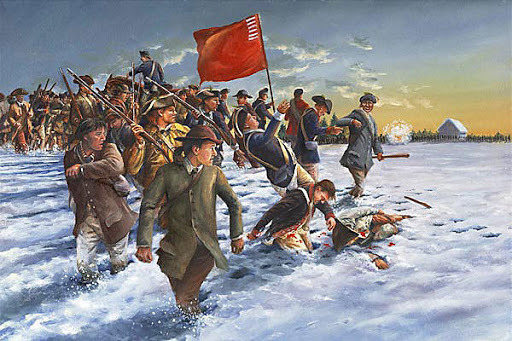
Shays' Rebellion (1786–1787) USA v. Citizens During Debt Crisis
Whiskey Rebellion (1791–1794) USA v. Citizens over TAXES
Quasi-War (1798–1800) Naval Pissing Match- USA v. France
Fries Rebellion (1799–1800) USA . PA Dutch Farmers over TAXES
First Barbary War (1801–1805) USA & Sweden v. N. Africa (Pirates)
German Coast Uprising (1811) Slave Rebellion in New Orleans v. USA
Tecumseh's War (1811) Native Annihilation.
War of 1812 (1812–1815) USA v. Britain over UK’s seizure of ships and men
Creek War (1813–1814) USA v. Alabama Native Americans
Second Barbary War (1815) Again.
First Seminole War (1817–1818) USA v. Florida Native Americans
Texas–Indian Wars (1820–1875) USA v. Texas Natives & Spain/Mexico
Arikara War (1823) USA v. Sioux Native Americans
Aegean Sea Anti-Piracy Operations of the United States (1825–1828)
Winnebago War (1827) USA v. Wisconsin Native Americans
First Sumatran expedition (1832) USA v. Indonesia
Black Hawk War (1832) USA v. Ill & Mich Native Americans
Texas Revolution (1835–1836) USA v. Mexico to steal Tex-ass
Second Seminole War (1835–1842) USA v. Native Americans in Florida
Second Sumatran expedition (1838)
Aroostook War (1838) USA v. Britain over N. Brunswick & Maine Border
Ivory Coast expedition (1842) USA v. Bereby, W. Africa against Slavers
Mexican–American War (1846–1848) USA v. Mexico to seize TX, NM & CA
Cayuse War (1847–1855) USA v. Oregon Native Americans (Annihilation)
Apache Wars (1851–1900) USA v. Apache Native Americans in s.west

Bleeding Kansas (1854–1861) USA v. USA Kansas & Missouri Conservative PRO-Slavery versus Abolitionist/Progressive ANTI-Slavery in new territories.
Puget Sound War (1855–1856) USA v. coastal Wash. State Native Americans
First Fiji expedition (1855) USA v. Fiji over the islanders not wanting rich American fucks there anymore. We did away with that by force, by Harry!
Rogue River Wars (1855–1856) USA v. Oregon Native Americans
Third Seminole War (1855–1858) USA purges last of Florida Natives
Yakima War (1855–1858) USA v. Washington Native Americans
Second Opium War (1856–1859) USA, Britain & France v. China over forcing the Chinese to buy opium to keep them compliant
Utah War (1857–1858) USA v. The F’n MORMONS This was the Waco Tex-Ass of its time.
Navajo Wars USA v. New Mexico Native Americans (Long Walk)
Second Fiji expedition (1859) USA v. Fiji. We told them once...
John Brown's Raid on Harpers Ferry (1859) USA v. USA, Prelude to Civil War
First and Second Cortina War (1859–1861) USA (Then CSA) v. Mexico in TX
Paiute War (1860) USA v. Nevada Native Americans
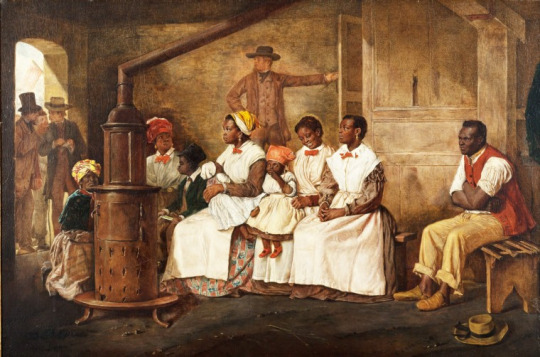
American Civil War (1861–1865) USA v. CSA
Yavapai Wars (1861–1875) USA v. AZ Native Americans
Dakota War of 1862 (1862) USA v. Minnesota & Dakota Native Americans
Colorado War (1863–1865) USA v. Colorado, Wyoming & Nebraska Natives
Shimonoseki War (1863–1864) UK, USA, France, Dutch v. Japan over straight between Japan’s own islands.
Snake War (1864–1868) USA v. Native Americans in Oregon, Nevada, Idaho & California
Powder River War (1865) USA v. Native Americans in Montana & Dakota
Red Cloud's War (1866–1868) USA v. Native Americans in Wyoming & Montana
Formosa expedition (1867) USA v. Taiwan Natives in response to massacre of crew of wrecked USS Rover, a small bark.
Comanche Campaign (1867–1875) USA v. Native Americans in western states/territories
Korea expedition (1871) USA v. Korea in retaliation for being shot at because they hated us.
Modoc War (1872–1873) USA v. Native Americans in N. Cali & Oregon.
Red River War (1874–1875) USA v. Native Americans in S.W.
Las Cuevas War (1875) USA/TX v. Mexican Raiders
Great Sioux War of 1876 (1876–1877) USA v. Native Americans in S.W.
Buffalo Hunters' War (1876–1877) USA v. Native Americans in TX & OK
Nez Perce War (1877) USA v. Native Americans in Oregon, Idaho, Wyoming & Montana
Bannock War (1878) USA v. Native Americans in Oregon, Idaho & Wyoming
Cheyenne War (1878–1879) USA v. Native Americans in Oklahoma, Kansas, Nebraska, S. Dakota and Montana
Sheepeater Indian War (1879) USA v. Native Americans in Idaho
Victorio's War (1879–1881) USA/Mexico v. Apache in Mexico
White River War (1879–1880) USA v. Native Americans in Colorado
Pine Ridge Campaign (1890–1891) USA v. Native Americans in S. Dakota
Garza Revolution (1891–1893) USA & Mexico v. Mexican Revolutionaries
Yaqui Wars (1896–1918) USA/Mexico v. Native Americans in Mexico & AZ
Second Samoan Civil War (1898–1899) USA v. Germany over Samoa Control because screw the natives already living there.
Spanish–American War (1898) USA v. Spain- when the US wanted to bugger Spain and used the likely accidental destruction of the USS Maine (”Remember the Maine!”) in Havana Harbor as an excuse for war.
Philippine–American War (1899–1902) USA v. Philippines because we won you from Spain in the last war; screw you if you’re a native on the island.
Moro Rebellion (1899–1913) USA v. Philippines because while we’re here, we’ll meddle in your politics too.
Boxer Rebellion (1899–1901) USA v. China because they wanted those douchebag imperialists, foreigners and goddamn Christians to simply fuck the hell off back to where they came from because they suck.
Crazy Snake Rebellion (1909) USA v. OK Native Americans because Americans just LOVE betraying treaties and killing the native population.
Border War (1910–1919) USA v. Mexico & Germany because it’s more fun to play with guns and kill one another rather than sit at a table with a map and come to an amicable agreement.
Negro Rebellion (1912) USA v. Cuba (under US control from war with Spain) where we literally went in and slaughtered Afro-Cubans for wanting freedom. (Part of the Banana Wars)
Occupation of Nicaragua (1912–1933) USA v. Nicaragua where the US seized land and occupied it because a canal was going to be built and never was. Oops. (Part of the Banana Wars)
Bluff War (1914–1915) USA v. Native Americans in Utah and Colorado. Again. Why should the last generation have all the fun, right?
Occupation of Veracruz (1914) USA v. Mexico. Because fuck those Mexicans, right?
Occupation of Haiti (1915–1934) USA v. Haiti because why not? We own you now. (Part of the Banana Wars)
Occupation of the Dominican Republic (1916–1924) USA v. D.R. because we may as well own you too while we’re in the area.
World War I (1917–1918)
USA arriving very late in the “War to End All Wars”. “Thanks for nothing,” said the allies, “But please; take all the credit.”
Russian Civil War (1918–1920) USA & Europe v. Bolshevik Russia which didn’t end well for the USA & allies. We totally lost that one.
Last Indian Uprising (1923) USA v. Native Americans in Utah because we’d rather have Mormons than the Ute and the Paiute tribes.
World War II (1939–1945)
USA fights Japan covertly in the Pacific, aiding China against Japanese aggression. USA assists Britain and occupied Europe against the FASCIST regimes of Hitler’s Nazis and Mussolini in Italy and fucks off until the Attack of Pearl Harbor in 1941. “Oh, THIS shit again?” asks Europe. “Showing up late YET AGAIN, but sure; hey, USA, take all the credit yet again. Seriously, fuck you guys. Thanks for the assist, but we could have saved millions of lives of you’d gotten of your fat asses YEARS ago!”
Korean War (1950–1953) USA v. N. Korea in a proxy war with the USSR and China because fuck those commies, right? We won, even though they kicked our asses and a formal treaty was NEVER signed so technically the war is actually STILL ON.
Laotian Civil War (1953–1975) USA v. Laos and those commie scumbags. Yep. We don’t talk about this one because we LOST.
Lebanon Crisis (1958) USA v. Lebanon, Beirut, because we like Christians and fuck those Muslim twats, right? (God, we’re not a good people in the US...)
Bay of Pigs Invasion (1961) USA & Cuban Revolutionaries v. Cuban Government because fuck the commies. Maybe if we help, we’ll own Cuba again... Oops. Nope. Totally fucked that up.
Simba rebellion, Operation Dragon Rouge (1964) USA and EU Allies v. S.E. Asia in amounted to a total clusterfuck that dissolved Vietnam and was a precursor there as well as other areas. It helped the rise of dictators all throughout the region. Khmer Rouge anyone?
Vietnam War (1955–1975) USA, S. Vietnam, Australia, New Zealand etc. v. China-backed, USSR backed N. Vietnam. The Imperialist WEST v. the Communist EAST. That ended in a shit-show for the West like all proxy wars in southeast Asia do.
Communist insurgency in Thailand (1965–1983) USA/Local allies v. China/ally backed communist rebels. Pretty much a draw that petered out and Communism didn’t really stick... sort of.
Korean DMZ Conflict (1966–1969) USA v. N. Korea because they attempted to convince the S. Koreans to rise up and join the North, throwing out the WEST. No dice for them.
Dominican Civil War (1965–1966) USA v. Dom. Republic insurgents to restore Dem elected government. It worked so well that we would decide never to really do that sort of thing again when doing it the opposite way gets us more money.
Insurgency in Bolivia (1966–1967) USA (CIA) & Bolivia stomp out Che Guevara because we’ll have none of this uprising shit.
Cambodian Civil War (1967–1975) USA v. Cambodian communists, because we were in the area anyway... “THE KILLING FIELDS” happened.
War in South Zaire (1978) USA & Allies v. USSR & Allies in Africa. Yes, another Cold War proxy war. Finally, the US wins one. Yay.
Gulf of Sidra encounter (1981) USA v. Libya- a pissing contest over a line in the water. Libyan fighters fire upon US fighters and get their asses handed to them. USA! USA! USA!
Multinational Intervention in Lebanon (1982–1984) USA joins the U/N to shaft the P.L.O. and Muslims in Lebanon because fuck them and we love Israel.
Invasion of Grenada (1983) USA v. Cuban-backed commie bastards who overthrew the democratically elected government. I know we said we wouldn’t do that again, but we hate Cuba more than these guys.
Action in the Gulf of Sidra (1986) USA v. Libya because fuck you, Qaddafi, and that bullshit line in the water. We’re sending a carrier group in to show YOU where the REAL line is.
Bombing of Libya (1986) USA v. Libya because they keep bombing shit around Europe and they make us keep coming back. France still likes Libya and wouldn’t let US fighters through their airspace as they left German air bases. US pilots were a bit fatigued having to go around the long way and ‘accidentally’ bombed the French Embassy in Libya...
Tanker War (1987–1988) USA v. Iran because fuck them, that’s why. Iran & Iraq were duking it out and Iran thought shooting at US and allied shipping would be good fun. USS Vincennes then shot down Iran Air Flight 655, killing 290 passengers; 66 of which were children. Yeah, we totally fucked that up hard-core.
Tobruk encounter (1989) USA v. Libya. Again. That line. US F-14′s splash their MIGs. Now, stay. Good Libya.
Invasion of Panama (1989–1990) USA v. Panama dictator Manuel Noriega because he’s an evil cunt. No, not really. It was because he wouldn’t play ball with the US and the CIA. He was a drug lord anyway so fuck him.
Gulf War (1990–1991) USA & Allies v. Iraq because Saddam Hussein needed his dick slapped the fuck back out of Kuwait, a US & EU ally.
Iraqi No-Fly Zone Enforcement Operations (1991–2003) USA v. Iraq, because every now and then we had to go blow up some of their shit and keep them in their place.
First U.S. Intervention in the Somali Civil War (1992–1995) USA & Allies v. Somalia because why not? Lots of shooting, lots of dead, and nothing accomplished. The war is STILL going on.
Bosnian War (1992–1995) USA v. Bosnian, post USSR dictators because the US/NATO won’t act until AFTER the genocides...
Intervention in Haiti (1994–1995) USA v. Haiti, because damn it, we’ll restore your democratically elected government and put down that coup... for a price...
Kosovo War (1998–1999) USA and a fuck ton of allies v. Russia-backed Yugoslavia because human rights violations are for US southern CSA states only, fuckers. We sort of won this ‘contest’.
Operation Infinite Reach (1998) USA v. Al Qaeda in Afghanistan, because fuck those ‘towelheads’ we helped push out the Russians! How dare they turn on us imperialists when we treat them like peasants and shit on them? What nerve! How will Big Pharma keep up their poppy fields now? This means war...
THE 21st CENTURY
War in Afghanistan (2001–present)
2003 invasion of Iraq (2003) & Iraq War (2003–2011)
War in North-West Pakistan (2004–present)
Second U.S. Intervention in the Somali Civil War (2007–present)
Operation Ocean Shield (2009–2016) USA v. Somali pirates
International intervention in Libya (2011) Because enough, Qaddafi.
Operation Observant Compass (2011–2017) USA v. Uganda because of terrorist camps
American-led intervention in Iraq (2014–present) USA v. ISIS/ISIL in Iraq. Thanks, Obama; right?
American-led intervention in Syria (2014–present) USA v. ISIS/ISIL in Syria where we rounded up lots of ‘terrorist’ fighters.
Yemeni Civil War (2015–present)
American intervention in Libya (2015–present) USA v/ ISIS/ISIL in Libya. It’s as if the war in Iraq pissed off a ton of people in the region along with Israel’s expansion into Palestine territory over the years... Go figure.
THE TRUMP YEARS
Despite fucking over our allies in Syria and being far too cozy with Putin and Kim Jong Un and other dictators, sympathizing with Nazis in the US and having the KKK in his blood, trumplefuckstick hasn’t actually pushed any “NEW” wars upon the US so far. Sure, we’re in a state of chaos and about to collapse into a failed nation-state into that “shithole country” everyone thinks can’t happen here.
The point is:
“HEY JOE FUCKIN’ BIDEN! I DON’T MEAN TO THROW YOU OFF YOUR GAME HERE BUT WHILE I DO NOT CONDONE VIOLENCE, IT SEEMS THAT AS AMERICANS, IT’S THE ONLY WAY WE DO THINGS HERE TO GET SHIT DONE!”

Still don’t believe me? How about some non-war stuff...
How about EVERY act of white supremacist, KKK driven TERROR on non-whites since the Civil War ended or of the slave owners before them?
How about how our first real “police” in the US were bounty hunters looking for runaway slaves?
How about the Tulsa race massacre when white mobs attacked the black residents and business of the Greenwood District in Tulsa because the good people of Oklahoma didn’t want them “uppity niggers” to be doing as well or better than the white racist fucks were doing. That learned ‘em, didn’t it?
Let’s not forget the anti-union suppression! How about the Herrin Massacre? During a United Mineworkers of America nationwide strike union miners shot at strikebreakers working at the mine. The mine's guards killed three union miners on June 21, and the miners killed 20 strikebreakers and guards on June 22.
What about the Hanapepe Massacre? During a strike of Filipino sugar workers, in an attempt to rescue two hostage strikebreakers police killed 16 strikers, while strikers killed four law enforcement members.
Kent State shootings: During a protest of the bombing of Cambodia at the University, members of the Ohio National Guard opened fire, killing four and injuring nine people.
Jackson State University shooting: After responding to the University due to a growing unrest, officers opened fire on a dorm building and two students (one from a local high school) were killed and twelve were injured.
There are more, to be sure, but Mr. Biden, you ARE correct in one particular field here- gun violence. Look at this list HERE. So many acts of mass shootings going WAY back before Columbine. What’s been done about this by you, the Democrats or Republicans of the piece-of-shit NRA? Fuck-all NOTHING.
Your truth, Mr. Biden- in this instance, gun violence literally achieves NOTHING.

https://en.wikipedia.org/wiki/List_of_wars_involving_the_United_States
https://en.wikipedia.org/wiki/List_of_mass_shootings_in_the_United_States#1920s
76 notes
·
View notes
Photo



Paul Schutzer: Lebanon Crisis (1958) Frolicking US Soldiers © LIFE
160 notes
·
View notes
Photo

View of a pair of US Marines as they rest in the shade of an M48 Patton tank during the Lebanon Crisis, Beirut, Lebanon, July 1958. An unidentified American ship lies offshore.
19 notes
·
View notes
Text
lebanon crisis explained - to the best of my ability and knowledge <3
- my information is mostly from @arabsforjustice on instagram!! and articles i found on google! credit to them! ✨✨✨
the lebanon crisis, is nothing new. it’s been going on for years and years. The 1958 Lebanon crisis was a Lebanese political crisis caused by political and religious tensions in the country that included a United States military intervention.
One of the major environmental issues in Lebanon is water supply. The country has greater water resources than many other Middle Eastern countries; however, it is at increasing risk of shortages, particularly during the dry summers. This is due to lack of storage capacity, to increasing demand, and to climate change.
tens of thousands of citizens have been pushed to poverty.
the middle and lower class are unable to afford basic necessities such as food and shelter.
since october 2019, the lebanese lira has lost over 80% of its value. the devaluation to the lebanese lira lead the government to propose a tax on tobacco, petrol, and whatsapp voice calls to earn more revenue.
however the tax unleashed a cycle of protests by frustrated citizens.
why is lebanon frustrated?
- the devaluation of the lira
- the corruption in the government
- the gap between social classes
WAYS TO HELP!
- [ ] donate, if you look up lebanon crisis donate, lots of petitions and places to donate will pop up !!
- [ ] second, please share. i know it won’t do much, but it will spread awareness and educate a lot of people.
- [ ] sign petitions ! i know it seems like it won’t work, but trust me, it will :)
i hope i explained this as well as i could! i got a lot of information from threads and articles!! please participate in helping lebanon <3
2 notes
·
View notes
Text
Events 9.14 (after 1940)
1940 – Ip massacre: The Hungarian Army, supported by local Hungarians, kill 158 Romanian civilians in Ip, Sălaj, a village in Northern Transylvania, an act of ethnic cleansing. 1943 – World War II: The Wehrmacht starts a three-day retaliatory operation targeting several Greek villages in the region of Viannos, whose death toll would eventually exceed 500 persons. 1944 – World War II: Maastricht becomes the first Dutch city to be liberated by allied forces. 1948 – The Indian Army captures the city of Aurangabad as part of Operation Polo. 1954 – In a top secret nuclear test, a Soviet Tu-4 bomber drops a 40 kiloton atomic weapon just north of Totskoye village. 1958 – The first two German post-war rockets, designed by the German engineer Ernst Mohr, reach the upper atmosphere. 1960 – The Organization of Petroleum Exporting Countries (OPEC) is founded. 1960 – Congo Crisis: Mobutu Sese Seko seizes power in a military coup, suspending parliament and the constitution. 1975 – The first American saint, Elizabeth Ann Seton, is canonized by Pope Paul VI. 1979 – Afghan leader Nur Muhammad Taraki is assassinated upon the order of Hafizullah Amin, who becomes the new General Secretary of the People's Democratic Party. 1982 – President-elect of Lebanon Bachir Gemayel is assassinated. 1984 – Joe Kittinger becomes the first person to fly a gas balloon alone across the Atlantic Ocean. 1985 – Penang Bridge, the longest bridge in Malaysia, connecting the island of Penang to the mainland, opens to traffic. 1989 – The Standard Gravure shooting where Joseph T. Wesbecker, a 47-year-old pressman, killed eight people and injured 12 people at his former workplace, Standard Gravure, before committing suicide. 1992 – The Constitutional Court of Bosnia and Herzegovina declares the breakaway Croatian Republic of Herzeg-Bosnia to be illegal. 1993 – Lufthansa Flight 2904, an Airbus A320, crashes into an embankment after overshooting the runway at Okęcie International Airport (now Warsaw Chopin Airport), killing two people. 1994 – The rest of the Major League Baseball season is canceled because of a strike. 1997 – Eighty-one killed as five bogies of the Ahmedabad–Howrah Express plunge into a river in Bilaspur district of Madhya Pradesh, India. 1998 – Telecommunications companies MCI Communications and WorldCom complete their $37 billion merger to form MCI WorldCom. 1999 – Kiribati, Nauru and Tonga join the United Nations. 2000 – Microsoft releases Windows Me. 2001 – Historic National Prayer Service held at Washington National Cathedral for victims of the September 11 attacks. A similar service is held in Canada on Parliament Hill, the largest vigil ever held in the nation's capital. 2002 – Total Linhas Aéreas Flight 5561 crashes near Paranapanema, Brazil, killing both pilots on board. 2003 – In a referendum, Estonia approves joining the European Union. 2003 – Bissau-Guinean President Kumba Ialá is ousted from power in a bloodless military coup led by General Veríssimo Correia Seabra. 2007 – Financial crisis of 2007–2008: The Northern Rock bank experiences the first bank run in the United Kingdom in 150 years. 2008 – Aeroflot Flight 821, a Boeing 737-500, crashes into a section of the Trans-Siberian Railway while on approach to Perm International Airport, in Perm, Russia, killing all 88 people on board. 2015 – The first observation of gravitational waves is made, announced by the LIGO and Virgo collaborations on 11 February 2016. 2019 – Yemen's Houthi rebels claim responsibility for an attack on Saudi Arabian oil facilities. 2022 – Death of Queen Elizabeth II: The Queen's coffin is taken from Buckingham Palace, placed on a gun carriage of The King's Troop Royal Horse Artillery and moved in a procession to Westminster Hall for her lying in state over the next four days with the queue of mourners stretching for miles along the River Thames.
0 notes
Text
A Primer on Northern Syria
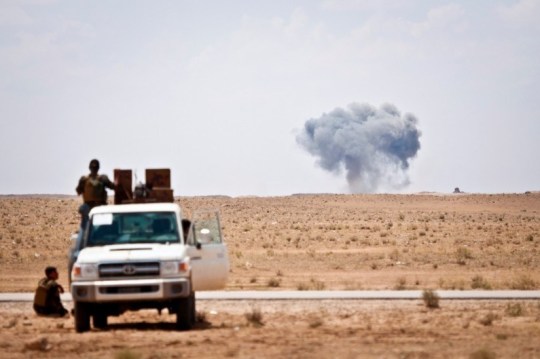
Originally posted on the Organise Aotearoa Blog on 14/10/19
Northern Syria, also known as the NES (Autonomous Administration of North and East Syria) or by its Kurdish name, Rojava (the west), is often in the news for all the wrong reasons. This week, Turkish troops and their local Islamist allies crossed the border in the name of protecting Turkey from Kurdish-led militants it denounces as terrorists. The US, ostensibly an ally of the Kurds, has granted Turkey a free hand to bomb the region at its leisure, and has assisted Turkey by closing off the border crossings with Iraq, and along the Euphrates. To understand the conflict holistically means we need to go far back into history, before capitalism, and before the ethno-nationalism it fostered could tear the region apart.
Pre-Capitalist History
Prior to the spread of Islam in the 600s, the region known as The Levant, or Lebanon, Palestine and Syria, was home to a number of competing religions. Greek Orthodox Christianity, Syriac Christianity, and Zoroastrianism (an ancient precursor to modern monotheistic religions) were all practiced across the region, along with smaller religions that can be traced back to the earliest human cities in Mesopotamia, such as the Yazidi religion. Most of these religions are still practiced by minorities in the region today, with the exception of Zoroastrianism which has been reduced to tiny enclaves much farther east.
In pre-capitalist times, humans have understood cultural differences quite differently to how we do today. It’s hard for many to understand now, but race and ethnicity were concepts that would only come into play later. Religious and cultural practice was a much more important and tangible aspect of identity. When Islam spread across the region, many Levantine peoples welcomed it because of its similarities to local forms of Christian iconoclasm (meaning religious opposition to figurative representation of the divine).

Map showing the spread of Islam under successive Caliphs.
Islam brought with it a renaissance period where Levantine peoples led the world in the arts and sciences. The conservative institutions of the Byzantine orthodox church, and Sassanid Zoroastrian fundamentalists were swept aside by a new wave of Islamic scholars and thinkers, whose rationalist approach now seems extremely modern compared to other cultures of the time. Islam was led by Caliphs, ideally philosopher-king descendents of the prophet, far removed from the more sinister modern use of the term.
By the late Middle Ages, the Caliphs were no longer direct descendents of the prophet, but rather powerful sultans who took on the title themselves. By the 1400s the Caliphs were a Turkish dynasty from central Anatolia, the Osmanolgu family, better known as the Ottomans. The Ottomans ushered in a second Islamic renaissance, and despite their brutal methods of warfare, were relatively fair administrators who allowed a great deal of autonomy for minorities. Christians, Jews and Muslims cohabited peacefully, to the point that whole cities were granted to minorities, such as the Jewish-led city of Salonica (Thessaloniki) in Greece.

Map showing the spread of the Ottoman caliphate.
However, this second period of peace wouldn’t always last. As the centuries passed, the Ottomans found themselves in direct competition with European powers, whose absolute monarchies and mercantilism proved to be a much stronger economic and political base. By the time of the Industrial revolution, the Ottomans were referred to as “The Sick Man of Europe.” A vast, but ultimately weak power, that could be easily divided up between the emerging European colonial powers.
The Ottomans adapted to this by adopting European-style cultural, political and economic practices. They experimented with colonial practices, beginning Turkish colonies across their provinces, and attempted to impose aspects of modern state power, like standing armies and police forces. These reforms were not enough, and the Ottomans found themselves being eaten alive by European powers. Napoleonic France took Egypt, Russia took Crimea, and Britain took Cyprus.
Capitalism reaches the Levant
This crisis led to growing anxiety amongst the emerging Turkish bourgeoisie. They feared that the Empire wouldn’t modernise fast enough to avoid disintegration, and that the Sultan needed to abolish the system of regional autonomy (the millet system), and replace it with a modern capitalist state under an absolute monarchy. Ottoman nationalism emerged as a means to consolidate the many regional identities, and a policy of “Turkification” was pursued throughout the empire. Capitalism requires a relatively homogenous populace in order to effectively create a working class to fuel industrial modernisation, and so the myriad ethnic identities of the empire presented a problem.
Several events in the first decades of the 20th century created the conditions for the form of Turkish ethnonationalism we see today. In 1908, Turkish army officers and the Ottoman bourgeoisie rose up in the Young Turk Revolution, demanding a liberal parliamentary system with representation for ethnic minorities. A counter-revolution in 1909 by reactionaries and proto-Islamists reversed some of the changes, and brought violence against ethnic minorities who were seen to be in support of the earlier revolution. The empire was now divided between liberal-bourgeois Ottomanism and reactionary Turkish ethnonationalism. A narrative of betrayal stemming from the loss of the Balkans in 1912 and an inability to mobilise the Anatolian Armenian population against Russia in 1914 added fuel to the flames. From 1915 to 1923, up to 1.5 million Armenians and other Christian minorities were systematically killed, the first modern genocide on an industrial scale, and a crime denied by Turkey to this day. Lesser known are the Greek and Assyrian massacres, which themselves account for up to a million additional deaths. Muslim populations historically allied to the Ottomans, such as Kurds and Circassians, participated in the killings.
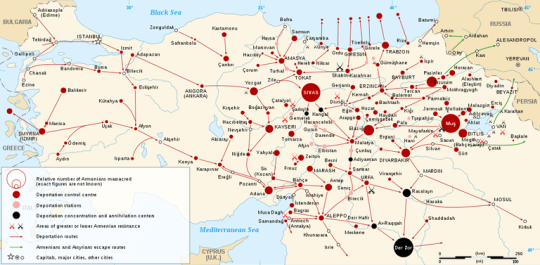
Map showing sites of documented Armenian and Assyrian genocide.
Ultimately neither clamping down on dissenting minorities, mobilising Turkish enthnonationalist sentiment, nor an alliance with the Central Powers of Germany and Austria-Hungary could save the empire. During the First World War, the “Sick Man of Europe” was finally carved up between the European colonial powers, after they successfully took advantage of a large scale Arab revolt by making false promises of statehood. The League of Nations, established in the aftermath of the war and the precursor to the modern UN, tasked various ‘responsible’ European powers with administering the conquered territories in the Levant and Mesopotamia.
The agreements signed during this period, in which the Arab revolt was thoroughly betrayed, would have profound implications, and are the source of many modern borders. Israel can trace its legacy back to this period; in the Balfour Declaration of 1917, Zionist immigration to Mandate Palestine was encouraged as a form of demographic engineering. The Sykes-Picot agreement led to the creation of Palestine, Transjordan (Jordan), Kuwait, and Iraq under British influence, and Lebanon and Syria under the French. Saudi Arabia, then known as the Emirate of Nejd, also participated in the partitioning by annexing the Ottoman Persian Gulf territories, and the lands captured in the Arab revolt by the rival Hashemites. In all of these territories, the Europeans encouraged regional nationalism and solidified the new borders, cutting several communities and tribes off from one another and effectively fracturing the entire region.
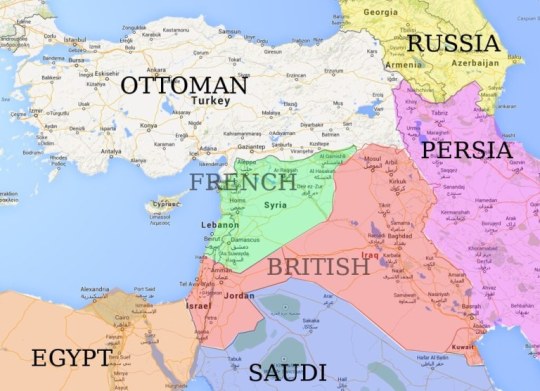
Map showing European zones of influence following WWI. Europeans also effectively controlled Egypt, Cyprus, and zones within Turkey, which is not shown.
The Mandate territories revolted against the Europeans several times. Turkey, occupied by the Europeans since 1918, successfully overthrew them in 1923, led by Mustafa Kemal Pasha (Atatürk), who attempted to combine the liberal-secular parliamentarism and Turkish ethnonationalism of the 1908 and 1909 revolutions into an ideology known as Kemalism. Palestine also attempted to overthrow the British in 1936 but was brutally crushed. Iraq attempted to do the same in 1941, even allying itself with Nazi Germany to do so, but was similarly put down.
After the end of the Second World War, the European powers were no longer able to exert direct control over the entire Levant, instead holding on to key areas like the Suez canal. The British also granted large parts of Mandate Palestine to the emerging Zionist movement as they believed an Israeli state would be more amenable to the West than the unruly Arabs. Pan-Arabism emerged in this period as a rejection of the atomisation, arbitrary borders, and demographic engineering that marked the European mandate territories. Wars against Israel and horror at its genocide of Palestinians would be a rallying cry for this movement, which resulted in a degree of consolidation in Levantine identity.
The Postcolonial Levant
Pan-Arabism would take on a social-democratic character as the various postcolonial states founded welfare systems, and allied themselves with the Soviet Union. However, the ideology was still strongly anti-communist on the domestic front. Indeed, anticommunism was the chief motive behind the zenith of Pan-Arabism: the attempt at a united Arab state in 1958. The United Arab Republic (UAR) was a union between Egypt and Syria, both led by social-democratic nationalist governments who feared that the alternative would be a Syrian communist revolution. Iraqi military officers soon overthrew their pro-Western monarchy and very nearly joined the UAR themselves.
Ultimately however, this sentiment would be short lived. As the threat of communism died down and the realities of post-colonial statehood set in, Pan-Arabism was replaced with a number of competing ideas. Marxists remained a strong faction, but would never again find themselves in a position to take power. Ba’athism, a legacy of the Pan-Arabist period, would later become the dominant ideology in Syria and Iraq, where its contradictory character would lead to both social-democratic reforms and the uneven repression of minorities and communists. Islamism, encouraged as a state ideology in Saudi Arabia, also became a powerful force, buoyed by its successes and US-funding in Afghanistan. Ethnonationalist separatism also emerged out of the decline of Pan-Arabism, which sharpened the contradictions facing minorities like the Kurds, Assyrians, and Armenians.
Modern Northern Syria
Northern Syria bears the marks of all of these competing ideologies from the postcolonial/Cold-War period, as well as the ethnic and religious divides from the preceding centuries. There are Marxist factions, generally split along ethnic lines between Kurds and Arab/Alawites; as well as Ba’athists; Islamists, most infamously ISIS; and ethno-nationalists of all stripes. Amongst them are the somewhat apolitical ethnic and religious minorities, like the Yazidis, who are motivated primarily by survival in the face of repeated threats of genocide. Newer factions include Kurdish Apoists, and the mercenary factions funded by various global powers.
Northern Syria is also the site of three major global battlegrounds. There is an expansionist and ethnonationalist Turkey seeking to quash Kurdish aspirations to nationhood; a regional battle between Saudi wahhabism (extreme Sunni fundamentalism) and Iranian principlism (revolutionary Shia Islam); and the US and EU making the most of the situation to access oil and guarantee long-term superiority over Russia. There are also smaller conflicts exploited by all parties, as well as the opportunism and warlordism that a collapse of civilian government and constant arms shipments engenders.
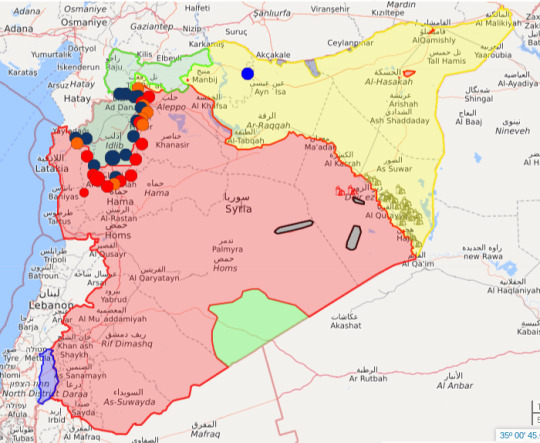
Map of the Syrian war as of October 13, 2019. Government (Ba’athist) areas are shown in red. Green areas are a mix of Western-backed militias (in Al-Tanf), Free Syrian Army remnants (in Idlib) and Turkish-backed militias (in the far north). Yellow is areas controlled by the SDF and Kurds. Black shows hardline Islamist remnants. Blue shows Israeli occupation.
Discussion of Northern Syria inevitably centers around the PYD (the Kurdish Democratic Union Party), arguably the most mythologised and interesting of all the Syrian factions. Depending on who you talk to on the internet, the PYD can be anything from anarchist insurrectionists, to Marxist revolutionaries, to eco-feminist warriors, to Kurdish terrorists, to Western imperialist Contras paid to undermine peace in the region. It’s our goal to demystify the group somewhat.
The PYD is the Syrian sister party of the PKK, the Kurdistan Workers’ Party, led by the imprisoned Abdullah Öcalan. Initially a Marxist group formed out of Kurdish students in Turkey, the PKK was forced underground by Turkish repression, becoming a guerilla army armed and supported by the Ba’athist governments of Iraq and Syria, who tolerated the PKK’s Marxist rhetoric so long as it was aimed at Turkey. The PKK of today is quite different, having dropped Marxism-Leninism and alliances with Ba’athism from its doctrine. The PKK and PYD, along with the other member parties of the KCK (Kurdistan Communities Union) umbrella organisation, have shifted towards enacting a democratic confederalist or “Apoist” (after a diminutive form of Öcalan’s name) programme in the predominantly Kurdish areas of northern Iraq and Syria, southeastern Turkey, and northwestern Iran. This gained a lot of attention in the west due to its communalist, feminist, and anti-capitalist aspirations. However, the system of autonomous cantons remains an admirable small-scale experiment, and tends to be overstated by the western left. The territory has also had difficulty living up to its ecological aspirations due to reliance on diesel generators, unregulated oil refineries, and wartime economic constraints.
The PYD and its armed wing, the YPG/YPJ, also gained infamy for its conditional alliance with the US and EU, whereby the Kurds and their allies gained air support, weapons and other assistance in return for allowing 10 US military bases on their territory. The US also assisted with arming the SDF (Syrian Democratic Forces), a broad military coalition that included the YPG/YPJ along with those whom it had previously opposed, such as Kurdish nationalists, religious Sunni Kurds, mercenaries, and conscripted soldiers of dubious willingness. As the result of US negotiations this new armed force came to control all lands north of the Euphrates, well beyond the initial territorial aspirations of the PYD, which had initially only included the majority-Kurdish regions in a strip along the northern border. This put the Kurdish-led military force in control of most of Syria’s oil fields, and a large population of Arabs and minorities critical of the SDF, the only Syrian faction to use forced conscription. Allegations of ethnic chauvinism, and the discovery of “blacksites” (interrogation and torture facilities) within SDF areas added to the criticism.

Map showing initial Kurdish territorial aspirations. De-facto Kurdish territories are now much larger.
Turkey is the main adversary of the Kurdish-led force. Since 2014 Turkey has been ruled by the fascist-adjacent and increasingly autocratic Recep Tayyip Erdoğan, whose Justice and Development Party is a direct descendent of the reactionary strain of Islamo-Turkish nationalism introduced in the counter-revolution of 1909. Turkish chauvinism towards Kurds stretches back decades, officially denying their existence and calling them “Mountain Turks” despite their historical loyalty in the Ottoman period.
Turkey is also in NATO, the US imperialist military alliance, however it often violates agreements with the US and makes overtures towards Russia, attempting to play both sides off against one another for military aid. Turkey has used this shaky alliance to lobby the US for more territorial control in Syria. The Afrin region was taken from Kurdish forces in 2016, and this week, vast swathes of northern Syria were declared up for grabs by Turkish expansionism.
Northern Syria invaded
Whatever our overall analysis of Syrian factions may be (and it is so easy to make mistakes in such a heavily propagandised environment) the question of the hour is Turkish expansionism, as this is the specific form that ethnonationalism has taken in the region. Turkey plans to demographically engineer a huge swathe of northern Syria by resettling 2 million refugees in NES, a move tantamount to a threat of genocide against displaced minorities. The US, for its part, has done far more harm than good as an ally, and is now patrolling the Euphrates, effectively enforcing the isolation of NES.
It would be a great mistake for people in the west to conclude that the people of Northern Syria somehow deserve a Turkish invasion as just desserts for their alliance with the US, especially since many Kurds and other minorities joined the fight in a struggle for survival against ISIS and Turkish-funded militias, only later finding their movement subverted by US geopolitical goals. Moreover, Turkey is the only faction in the Syrian conflict with a history of genocidal policies towards all of the minorities of Northern Syria at one point or another, and thus a defense of NES is a defense of all ethnic minorities in the region regardless of their political orientation.
All Syrian peoples deserve self-determination without the intervention of foreign powers. It may be easy to dismiss such a conflict as too complicated, the product of ‘tribal’ conflicts among a backwards people, but this ignores the entire history of imperialism in the Middle East. Thousands of ethnicities lived in relative peace prior to the imposition of nationalist ideology, demographic engineering and arbitrary borders, all products of capitalism. The Syrian people deserve an end to the constant war imposed upon them.
8 notes
·
View notes
Text
Some of the US interventions in the Middle-East since 1945
1949: Syria:
The democratically elected government of Shukri al-Quwatli was overthrown by a junta led by the Syrian Army chief of staff at the time, Husni al-Za'im, who became President of Syria on April 11, 1949. Za'im had extensive connections to CIA operatives.
1952: Egypt
Project FF or Fat Fucker was a Central Intelligence Agency project in Egypt, aimed at pressuring King Farouk into political reforms. The project was masterminded by CIA Director Allen Dulles, Secretary of State Dean Acheson, CIA operative Kermit "Kim" Roosevelt Jr., and CIA Station Chief in Cairo Miles Copeland, Jr. However, due to the unwillingness of Farouk to change, the project moved to support his overthrow, and Roosevelt secretly met with the Free Officers Movement, which overthrew Farouk in a coup d'état led by General Mohammed Naguib and Colonel Gamal Abdel Nasser on 23 July 1952.
1953: Iran
The 1953 Iranian coup d'état, (known in Iran as the "28 Mordad coup") was the overthrow of the democratically elected government of Iranian Prime Minister Mohammad Mosaddegh on August 19, 1953, orchestrated by the intelligence agencies of the United Kingdom (under the name "Operation Boot") and the United States (under the name "TPAJAX Project").
1956–1957: Syria
In 1956 Operation Straggle was a coup plot against Syria. The CIA made plans for a coup for late October 1956 to topple the Syrian government. The plan entailed takeover by the Syrian military of key cities and border crossings. The plan was postponed when Israel invaded Egypt in October 1956 and US planners thought their operation would be unsuccessful at a time when the Arab world is fighting "Israeli aggression." The operation was uncovered and American plotters had to flee the country.
In 1957 Operation Wappen was a coup plan against Syria. A second coup attempt the following year called for assassination of key senior Syrian officials, staged military incidents on the Syrian border to be blamed on Syria and then to be used as pretext for invasion by Iraqi and Jordanian troops, an intense US propaganda campaign targeting the Syrian population, and "sabotage, national conspiracies and various strong-arm activities" to be blamed on Damascus. This operation failed when Syrian military officers paid off with millions of dollars in bribes to carry out the coup revealed the plot to Syrian intelligence. The U.S. Department of State denied accusation of a coup attempt and along with US media accused Syria of being a "satellite" of the USSR.
There was also an assassination plot later, called "The Preffered Plan", in 1957 against many leaders in Syria. There would be a Free Syria committee set up and outside invasion would be encouraged. However this plan was never put through
1958: Lebanon
The U.S. launched Operation Blue Bat in July 1958 to intervene in the 1958 Lebanon crisis. This was the first application of the Eisenhower Doctrine, according to which the U.S. was to intervene to protect regimes it considered threatened by international communism. The goal of the operation was to bolster the pro-Western Lebanese government of President Camille Chamoun against internal opposition and threats from Syria and Egypt.
1959: Iraq
The October 1959 assassination attempt on Iraqi Prime Minister Abd al-Karim Qasim involving a young Saddam Hussein and other Ba'athist conspirators may have been a collaboration between the CIA and Egyptian intelligence. (There are conflicting reports on this one.)
1963: Iraq
Similar conflicting reports over US involvement in the February 1963 Iraqi coup.
1972–1975: Iraq
The U.S. secretly provided millions of dollars for the Kurdish insurgency supported by Iran against the Iraqi government. The U.S. role was so secret even the US State Department and the U.S. "40 Committee," created to oversee covert operations, were not informed. The troops of the Kurdish Democratic Party were led by Mustafa Barzani. Notably, unbeknownst to the Kurds, this was a covert regime change action the US wanted to fail, intended only to drain the resources of the country. The U.S. abruptly ceased support for the Kurds in 1975 and, despite Kurdish pleas for help, refused to extend even humanitarian aid to the thousands of Kurdish refugees created as a result of the collapse of the insurgency.
(Note that Trump’s betrayal of the Kurds is not the first time the US has done so).
1977–1988: Pakistan
Operation Fair Play was the code name for the 5 July 1977 coup by Pakistan Chief of Army Staff General Muhammad Zia-ul-Haq, overthrowing the government of Prime Minister Zulfikar Ali Bhutto. The coup itself was bloodless, and was preceded by social unrest and political conflict between the ruling leftist Pakistan Peoples Party government of Bhutto, and the right-wing Islamist opposition Pakistan National Alliance which accused Bhutto of rigging the 1977 general elections. In announcing the coup, Zia promised "free and fair elections" within 90 days, but these were repeatedly postponed on the excuse of accountability and it was not until 1985 that ("party-less") general elections were held. Zia himself stayed in power for eleven years until his death in a plane crash.
The coup was a watershed event in the Cold War and in the history of the country. The coup took place nearly six years after the 1971 war with India which ended with the secession of East Pakistan as Bangladesh. The period following the coup saw the "Islamisation of Pakistan" and Pakistan's involvement with the Afghan Mujahideen (funded by US and Saudi Arabia) in the war against the Soviets in Afghanistan.
1979–1989: Afghanistan
In what was known as "Operation Cyclone," the U.S. government secretly provided weapons and funding for a collection of warlords and several factions of Jihadi guerrillas known as the Mujahideen of Afghanistan fighting to overthrow the Afghan government and the Soviet military forces that supported it. Although Operation Cyclone officially ended in 1989 with the withdrawal of Soviet troops from Afghanistan, U.S. government funding for the Mujahideen continued through 1992, when the Mujahideen overran the Afghan government in Kabul.
1994–2000: Iraq (post Gulf War)
The CIA launched DBACHILLES, a coup d'état operation against the Iraqi government, recruiting Ayad Allawi, who headed the Iraqi National Accord, a network of Iraqis who opposed the Saddam Hussein government, as part of the operation. The network included Iraqi military and intelligence officers but was penetrated by people loyal to the Iraqi government. Also using Ayad Allawi and his network, the CIA directed a government sabotage and bombing campaign in Baghdad between 1992 and 1995, against targets that—according to the Iraqi government at the time—killed many civilians including people in a crowded movie theater. The CIA bombing campaign may have been merely a test of the operational capacity of the CIA's network of assets on the ground and not intended to be the launch of the coup strike itself. The coup was unsuccessful, but Ayad Allawi was later installed as prime minister of Iraq by the Iraq Interim Governing Council, which had been created by the U.S.-led coalition following the March 2003 invasion and occupation of Iraq. As a non-covert measure, the U.S. in 1998 enacted the "Iraq Liberation Act," which states, in part, that "It should be the policy of the United States to support efforts to remove the regime headed by Saddam Hussein from power in Iraq," and appropriated funds for U.S. aid "to the Iraqi democratic opposition organizations."
2003 to present: Iraq
The USA invades Iraq after falsely claiming Iraqi involvement in 9-11 and that they possessed weapons of mass destruction. See: Iraq War
2006–07: Palestinian territories
The U.S. government pressured the Fatah faction of the Palestinian leadership to topple the Hamas government of Prime Minister Ismail Haniyeh. The Bush Administration was displeased with the government that the majority of the Palestinian people elected in the January Palestinian legislative election of 2006. The U.S. government set up a secret training and armaments program that received tens of millions of dollars in Congressional funding, but also, like in the Iran-contra scandal, a more secret Congress-circumventing source of funding for Fatah to launch a bloody war against the Haniyeh government. The war was brutal, with many casualties and with Fatah kidnapping and torturing civilian leaders of Hamas, sometimes in front of their own families, and setting fire to a university in Gaza. When the government of Saudi Arabia attempted to negotiate a truce between the sides so as to avoid a wide-scale Palestinian civil war, the U.S. government pressured Fatah to reject the Saudi plan and to continue the effort to topple the Haniyeh government. Ultimately, the Haniyeh government was prevented from ruling over all of the Palestinian territories, with Hamas retreating to the Gaza strip and Fatah retreating to the West Bank.
2006–present: Syria
Since 2006, the State Department has funneled at least $6 million to the anti-government satellite channel Barada TV, associated with the exile group Movement for Justice and Development in Syria. This secret backing continued under the Obama administration, even as the US publicly rebuilt relations with Bashar Al-Assad.
This was followed by intervention in the Syrian Civil War, in part to combat ISIS/ISIL, with the USA supporting Syrian & Iraqi Kurdish forces. The US, under the Trump administration then abandoned the Syria Kurds to a Turkish intervention in 2019.
2007: Iran
In 2007, the Bush administration requested and received funding from Congress for covert actions in Iran that, according to a presidential finding that Bush signed, had the goal of undermining Iran's religious leadership.
2011: Libya
The United States has been active in post-2011 Libya with the military carrying out sporadic airstrikes and raids in the country, predominantly against Islamist groups.
2015–present: Yemen
The U.S. has been supporting the intervention by Saudi Arabia in the Yemeni Civil War. The Yemeni Civil War began in 2015 between two sides, each claiming at that time to support the legitimate government of Yemen.
The U.S. military provides targeting assistance and intelligence and logistical support for the Saudi-led bombing campaign, including aerial refueling. The US also provides weapons and bombs, including, according to a Human Rights Watch (HRW) report, cluster bombs outlawed in much of the world and used by Saudi Arabia in the conflict. The United States also supports the war effort on the ground with Green Berets on the Yemen border with Saudi Arabia tasked initially to help the Saudis secure the border and later expanded to help locate and destroy Houthi ballistic missile caches and launch sites in what Senator Tim Kaine called a “purposeful blurring of lines between train and equip missions and combat.” The US has been criticized for providing weapons and bombs knowing that Saudi bombing has been indiscriminately targeting civilians and violating the laws of war.
3 notes
·
View notes
Photo

1958 Lebanon crisis- Pro-Government soldiers.
All are wearing the “Joanne d'Arc” French helmets. This model, developed post-WW2 as an 'all arms' helmet intended to be used throughout the French military, has clear lineage from the Adrian, although perhaps more so from the brimless helmets developed in the 1930s for motorised troops than the mle15 or mle26. Although its called the 1945 model there's no real evidence that any were actually produced before 1946; this is actually hard to be certain about because although some are dated many if not most are not.
7 notes
·
View notes
Photo




Sir Don McCullin
Renowned as one of Britain’s greatest living photographers, McCullin has captured images of conflict from around the world including Vietnam, Northern Ireland, Lebanon and Biafra.
McCullin began taking photographs in the 1950s, documenting his surroundings and local community in his native Finsbury Park, London. In 1958, his photograph The Guvnors, a portrait of a notorious local gang, was published in The Observer, launching his career as a photojournalist.
Working first for The Observer and then The Sunday Times Magazine, he went on to capture major conflicts around the world from Vietnam and the Congo to Cyprus and Beirut.
While McCullin has been best known as a photojournalist and war correspondent, he has also consistently engaged in documentary photography in Britain, depicting scenes of poverty and working-class life in London’s East End and the north of England.
From the homeless and disenfranchised population of Whitechapel in the 1970s to the industrial landscapes of Bradford, Liverpool and Durham, McCullin has exposed changing social conditions in the UK.
Grenade Thrower, Hue, Vietnam 1968 © Don McCullin
Local Boys in Bradford 1972 © Don McCullin
Protester, Cuban Missile Crisis, Whitehall, London 1962 © Don McCullin
Homeless Irishman, Spitalfields, London 1970 Tate © Don McCullin
#art#photography#don mccullin#war#vietnam#cyprus#beirut#Black and White#homeless#tate#poverty#human rights#children's rights#uk#equal rights#peace#ireland#democracy now#saddayfordemocracy
41 notes
·
View notes